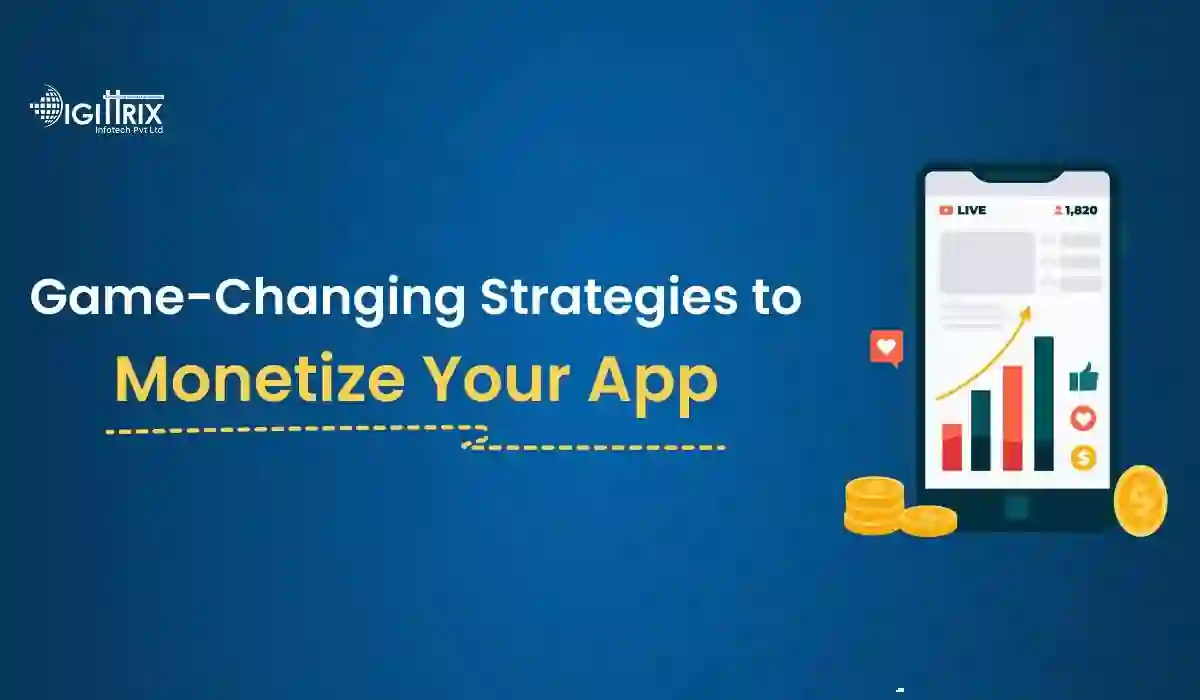App monetization is crucial for developers, with strategies like in-app ads, IAP, subscriptions, freemium, and paid apps driving revenue and user engagement across industries.
Highlights
An enthusiastic developer and skilled business management expert with over a decade of experience in the field

Monetizing your mobile app is a critical step in turning your development efforts into profit. Whether you're an entrepreneur looking to develop an on-demand app or a company offering mobile app development services, understanding the most effective strategies is essential. There are various ways to generate revenue from your app, each with its unique benefits and challenges. This article will discuss five popular app monetization strategies that can be implemented to achieve profitability.
Want to launch a marketplace app? Check Digittrix's step-by-step guide to create a successful platform!
In-app advertising is one of the most common and accessible ways to generate revenue from a mobile app. This strategy involves displaying ads within the app to users. Ads can be shown in various formats, including banners, pop-ups, interstitials, and videos. The app earns money each time a user interacts with an advertisement or views it.
There are several ad networks that developers can join to display ads in their apps, such as Google AdMob, Facebook Audience Network, and others. These platforms allow app developers to place ads based on user preferences, location, and browsing behavior, increasing the likelihood of user interaction with ads.
For mobile app developers, in-app advertising can be a simple and fast way to monetize an app without needing to charge users directly. However, it is essential to strike a balance. Too many ads can lead to a poor user experience and cause users to abandon the app. Keeping ads relevant and non-intrusive is crucial.
Global app revenue reached $407.3 billion in 2023, with in-app purchases dominating the market. Statista
In-app purchases (IAP) is another popular monetization model, especially in mobile gaming. This strategy allows users to buy virtual goods, upgrades, or other content directly within the app. Developers can offer basic functionality for free, but users can purchase additional features or content to enhance their experience.
For example, a gaming app may allow users to buy extra lives, power-ups, or exclusive skins. Non-gaming apps might offer premium features or exclusive content through in-app purchases. This method works particularly well when you offer value that users are willing to pay for.
While this strategy allows app developers to generate significant revenue, the key is ensuring that the in-app purchases provide real value to users. If the app is too reliant on paid content, it may alienate free users.
Subscription-based apps saw 40% of revenue from recurring payments in 2023, increasing user retention. Apps Run The World
The subscription model has become increasingly popular across a variety of industries. Instead of relying on a one-time purchase or ad revenue, a subscription model allows users to pay a recurring fee for access to exclusive content, features, or services.
This model works well for services that offer continuous updates, such as news apps, fitness apps, or media streaming services. It provides developers with a steady and predictable revenue stream, which is vital for long-term profitability. Subscriptions can be offered weekly, monthly, or yearly, depending on the type of content and app.
For example, a fitness app could offer a free version with limited features, but users would need to subscribe for full access to workout programs, personalized training plans, or nutrition guides. Similarly, a news app could provide daily updates and premium content for subscribers.
When implementing a subscription model, it's crucial to offer value that justifies the recurring payments. This could be in the form of regularly updated content, exclusive features, or a community experience that keeps users engaged.
According to Forbes, Freemium model apps grew by 50%, with 20% of users upgrading to premium versions globally.
The freemium model combines the best of both free and paid content. It allows users to access a basic version of the app for free, while offering premium features or content for a fee. The freemium model works particularly well for apps that can provide both a free and a premium version without limiting the overall app experience.
For example, a photo-editing app might allow users to use basic filters and editing tools for free, but charge for advanced features, such as premium filters or special effects. Similarly, a productivity app might provide access to basic project management features but require users to pay for advanced features, such as unlimited storage or team collaboration tools.
The goal with the freemium model is to get users hooked on the free version of the app, and then convert them into paying customers by offering them additional value through premium options. However, developers must ensure that the free version is still enjoyable and useful, as users need to be satisfied before they are willing to pay for additional content.
Launching a startup? Avoid costly errors! Check Digittrix's expert guide to set your business up for success!
One of the simplest monetization strategies is selling your app for a one-time fee. Users pay upfront to download the app and gain access to its content or features. This model works best for apps that offer significant value or unique features, and the user is willing to pay for it.
Paid apps are common for high-quality, niche apps where users expect to pay for the product. This could include professional tools, educational apps, or specialized services. For example, a language-learning app or a professional photography app may offer advanced features that justify the upfront cost.
While a paid app can generate a significant amount of revenue, the downside is that you may limit your audience. Some users may be reluctant to pay for an app without trying it first, so offering a free trial or demo version could help increase conversions.
Selecting the right app monetization strategy depends on the nature of your app, your target audience, and the type of user experience you want to provide. Whether you choose in-app advertising, in-app purchases, subscriptions, the freemium model, or a paid app model, it's important to ensure that the chosen strategy aligns with your app’s purpose and adds value to the user experience.
For businesses seeking expert help in implementing these strategies, partnering with an app development company that offers mobile app development services is a great way to bring your vision to life. Whether you’re looking to build an on-demand app or develop a more complex mobile application, an Android or iOS app developer can help customize your app’s monetization approach to fit your needs.
By carefully considering the various monetization models and choosing the right one for your app, you can ensure a profitable future for your mobile application while also providing users with value-driven experiences.
In today’s digital era, mobile apps are not just about functionality but also about generating revenue. Whether it’s a free app with ads, a subscription-based platform, or a premium service, choosing the right monetization strategy is key to success. The best approach depends on factors like target audience, app type, and market trends.
At Digittrix, we specialize in mobile app development, helping startups and enterprises integrate effective monetization models. Whether you need in-app purchases, ad-based revenue, subscription plans, or a freemium model, our expert team ensures a seamless implementation that maximizes profitability.
Want to find the best monetization strategy for your app? Schedule a consultation with our experts today by calling +91 8727000867 or emailing digittrix@gmail.com.
Let’s turn your app into a profitable business with the right revenue model!

Do you need help in Mobile App development?




Join over 1500+ businesses we've already helped!
The best strategy depends on the app type, but in-app ads and freemium models are popular choices for beginners.
In-app purchases allow users to buy virtual goods, premium content, or additional features within the app.
Subscriptions provide recurring revenue, whereas one-time purchases offer immediate income but may limit long-term profits.
Yes, combining strategies like in-app purchases with ads or subscriptions can maximize revenue potential.

©2025Digittrix Infotech Private Limited , All rights reserved.